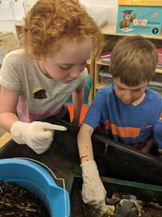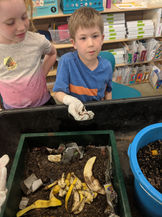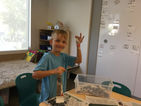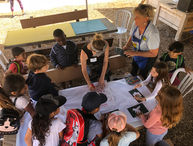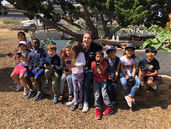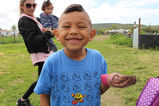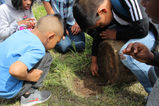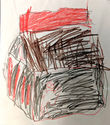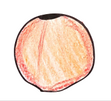

Grow It
Don't Throw It
First Graders at High Tech Elementary took a hard look at the waste our school produced and reflected on ways to reduce waste within our community.
Project Handout

Project Photos
Prototypes
Storyboard
Prototype
An example of a storyboard for a piece of the Waste Sort Video. The video above was made with this storyboard.
An example of artwork drafting process with improvement based on student critique.
Artwork Drafts
Prototype
Board Game Prototype
Board Game Prototype
An example of what a waste sort board game could look like.
Waste Sort Sign Prototype
An example of what a waste sort sign can look like.
Video Prototype
Student Work



School Waste Artwork
Students learned about vermicomposting and recycling in order to help teach our community how to sort their trash. Students drew waste items we found in our school waste inventory. They completed these drawings through a series of multiple drafts. These drawings were used in our final products to teach our community about the waste we produce.
Waste Sort Bin Signs
The Sign Group felt it was extremely important to make signs to help our school know where to put their waste. The school waste drawings were used in the signs. The sign group introduced this resource to the whole school at a community meeting. They spoke in efforts to persuade our community to use the signs.

Waste Sort Games

The Game Group made 3 different card/board games to help educate our community because we know learning can be FUN!


Waste Sort Video Quiz
The Video Group made a quiz video to help educate our community. They learned to use apps like Stop Motion and Chatter Pix to make this amazing video.
Artist's Statement
When first grade was brainstorming project ideas my cooperating teacher shared a mini-project that she had done the previous year at HTE Chula Vista in which they built vermicompost bins and explored worms. We wanted to expand upon the vermicompost idea to address our school's trash problem. Our school has had a number of community meetings where we had to call attention to some of the issues with students not putting their trash in bins or not sorting trash. It was making a lot of extra work for the building's management and also expressed disrespect toward our community. We started this work by presenting the problem to the students. We took pictures of trash around the school to show them the problem. Our community expert, Mr. Paul, taped a video for the students about some of the trash problem he has observed. Ms. Julia lead a team of second graders in a mini project where they looked through what was in just one regular trash bag and they shared their results with us.
The students were able to find purpose in discussing the trash problems in our community. They would call attention to trash they noticed everywhere and often take action. We talked about some of the different things that we could do to help. Lots of their ideas surrounded recycling and reusing were shared. As a school we are not allowed to share food and the students had a hard time with how much food is wasted because it can't be shared, reused or recycled. The students also shared a problem where the cafeteria requires them to take a certain amount of vegetables and fruit each time they buy a school lunch. Most of the vegetables and fruit get wasted, often thrown in the trash or dropped on the floor. We wanted to figure out a solution that not only helps our trash problem but minimizes the amount of food waste.
We presented the kids with some learning opportunities around what happens to the trash we send to the landfill. Students were really struck by what happens at landfills and their effect on the environment. We learned of vermicomposting and the kids were immediately intrigued. They were so excited and interested in the idea of raising worms and also repurposing our food waste. We knew that we were going to make vermicomposting bins but we wanted a product that demonstrated all our learning about waste management and worm anatomy. We had the idea to make a video to teach others about vermicomposting and write opinion pieces that would help them build on their understanding of the reasons that we were doing this smelly work for our community. We originally thought of a “how to make a vermicompost bin” video. After reflecting on our hopes for the community, it became clear we needed a video that taught our community what can go in the vermicompost bin. If we were going to expect people to compost we needed to teach them how.
The new product was a quiz video in which the students shared information about the vermicomposting and recycling and then tested viewers on their trash sorting skills. We wanted to provide the community with more resources to develop their sorting skills. The students were to become experts and teachers. We had decided on three separate projects. We were making the trash sorting quiz video, a board game that would help students practice their sorting skills, and signs that could go up around our community near trash cans helping students remember how to sort different trash items. Our goal for this project was to train our community to be ready to compost when we finally had a more permanent from a composting system.
We decided that the students would go through the trash in our school and see what was not being sorted properly. We did our trash survey inside of our classroom it just so happened to be on the same day as the lockdown. We had to eat inside during the lockdown and then surveyed the trash from that lunch. I think that it really helped them see how their contribution of trash impacts opportunities to recycle. We tallied each item we found in the waste bag into the category it could have gone. After seeing what our community was having trouble sorting we made a list of things that we wanted to teach people to sort. Students chose a trash item that they would draw. We knew that we wanted to use these materials to help educate our community. We had the students critique other people's trash sorting signs to try and decide what we needed to have in a good sorting sign. I made a prototype drawing of an item of trash so that the students could go through the critique process with my work and identify the qualities that made it a great drawing. They used this scaffold to critique eachothers work. Together we identified what steps they needed to do to be able to complete their drawings.
After completing the drawings, I presented the students with prototypes of the three final products. I made sure that they knew that my prototypes were not my best work. I invited their feedback and invited new and different ideas of what the products could look like. We invited the students to reflect on their own interest and expertise in deciding which product they would like to focus on. The students reviewed the different tasks as if they were the duties for a job. Students filled out surveys expressing their preference of job, excited to choose what they were going to work on. The prototypes for the different products were presented in a way that made them seem equally as engaging. I did not present the video group with my video prototype but my storyboard and script. I presented the game group with my board game Prototype that was unplayable and my how to writing. The sign group was presented with my prototype of a sign and an opinion writing piece intended to be shared with our community at our community meeting. Planning for three separate products was challenging. I had ideas in mind for how to make these products work. I also really wanted student choice. I had difficulty finding a balance between student choice and effective time management.
I learned that I must carefully plan for group work roles to effectively incorporate each student's voice an amazing ideas into all of the products. In some of the groups, especially the gaming group, it ended up being multiple versions of the products within the group. Because of the personalized nature of this work it required more teacher support to help the students hash out their ideas and play test their game. With multiple small groups inside of a subgroup, it was a challenge to encourage all the ideas. With the video, some students were interested in being in the video while others are more interested the design for the video. If we had prototyped as a group and actually reflectively divided the responsibilities the products and challenges would feel more equitable and enriching for students. I do feel like we have included their voice I just feel like we don't have time to honor their voice.











